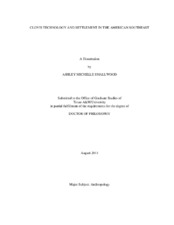| dc.contributor.advisor | Goebel, Ted | |
| dc.creator | Smallwood, Ashley Michelle | |
| dc.date.accessioned | 2012-10-19T15:28:55Z | |
| dc.date.accessioned | 2012-10-22T17:59:18Z | |
| dc.date.available | 2012-10-19T15:28:55Z | |
| dc.date.available | 2012-10-22T17:59:18Z | |
| dc.date.created | 2011-08 | |
| dc.date.issued | 2012-10-19 | |
| dc.date.submitted | August 2011 | |
| dc.identifier.uri | https://hdl.handle.net/1969.1/ETD-TAMU-2011-08-9891 | |
| dc.description.abstract | This dissertation presents new data on Clovis site occupation, technological organization, and settlement in the American Southeast. Evidence suggests that traditionally-accepted, western-centric models do not fully explain Clovis technological characteristics and settlement patterns in the region.
My second chapter presents the results of a 40 square meter block excavation on the Topper site (SC) hillside where a buried Clovis assemblage has been recovered. I review the site geomorphology and formation processes to evaluate the context of the Clovis component, characterize the Clovis assemblage and the horizontal distribution of artifacts to understand how the Clovis occupants used this portion of the site, and compare these excavation results to the rest of the archaeological record at Topper to discuss the general nature of the Clovis occupation there. My third chapter focuses on the 174 bifaces from Topper to understand biface production. I present the process of manufacture then measure the variation in production characteristics at the site in terms of our current knowledge of Clovis biface technology. I conclude that Topper flintknappers used reduction strategies typical of Clovis-but created a biface assemblage with greater flexibility in design than documented at most other Clovis sites. Clovis groups adapted to local resource conditions and adjusted the organization of their technology accordingly. My fourth chapter analyzes southeastern Clovis point data and biface assemblages from Carson-Conn-Short (TN), Topper, and Williamson (VA) to test the technological implications of Kelly and Todd’s (1988) high-technology-forager model and Anderson’s (1990) staging-area model. Significant subregional variation exists in Clovis biface systems, such as differences in point morphology and the tempo of biface reduction. This variation suggests the subregions represent distinct populations who distinctly altered aspects of their technology but maintained fundamental elements of the Clovis tradition.
Ultimately, I demonstrate there was greater variability in Clovis behavior across America. Recognizing regional variation in the archaeological record is key to understanding the complexities of Clovis origins and dispersal. | en |
| dc.format.mimetype | application/pdf | |
| dc.language.iso | en_US | |
| dc.subject | Clovis | en |
| dc.subject | Paleoindian | en |
| dc.subject | Lithic technology | en |
| dc.subject | American Southeast | en |
| dc.subject | Settlement | en |
| dc.subject | Site occupation | en |
| dc.subject | Technological organization | en |
| dc.subject | biface | en |
| dc.subject | biface production | en |
| dc.subject | Pleistocene | en |
| dc.title | Clovis Technology and Settlement in the American Southeast | en |
| dc.type | Thesis | en |
| thesis.degree.department | Anthropology | en |
| thesis.degree.discipline | Anthropology | en |
| thesis.degree.grantor | Texas A&M University | en |
| thesis.degree.name | Doctor of Philosophy | en |
| thesis.degree.level | Doctoral | en |
| dc.contributor.committeeMember | Waters, Michael | |
| dc.contributor.committeeMember | Carlson, David | |
| dc.contributor.committeeMember | Smeins, Fred | |
| dc.type.genre | thesis | en |
| dc.type.material | text | en |


